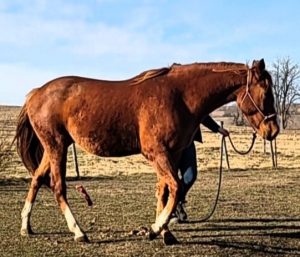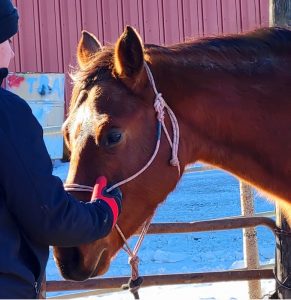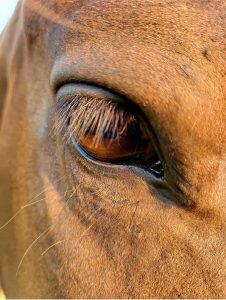Editor’s Note: Mckenzie Kammes is the founder of MK Horsemanship. Her mission is to help horse owners to better understand what horsemanship is like, mentally and physically, from the horse’s perspective. This work carries over to building a successful partnership. You can find her in Cuba City, Wisconsin.
Mckenzie writes:
 Riding a horse is like cutting potatoes. When we cut potatoes, we know knives are sharp, so we are usually careful when we use them. Because we know the knife could potentially cut us we have respect for the knife. We typically don’t fear it if we know how to position ourselves in a way that ensures success.
Riding a horse is like cutting potatoes. When we cut potatoes, we know knives are sharp, so we are usually careful when we use them. Because we know the knife could potentially cut us we have respect for the knife. We typically don’t fear it if we know how to position ourselves in a way that ensures success.
It’s all about positioning ourselves and letting the horse do its job. It is important to be thoughtful and aware when you are positioning yourself correctly before asking for a maneuver. Sometimes we move slowly and sometimes quickly. But the principle is the same regardless of the maneuver or speed.
When we cut a potato, we first envision how we want to cut the potato. Are we going to cut cubes or thinly slice it? Then we make sure our fingers are out of the way and positioned in the best way to help the knife cut through the potato. Once we are positioned correctly we can guide the knife confidently through the potato without resistance. We feel as the knife cuts through the skin and then to the middle and then as it sinks down to the cutting board.
 All of this often happens relatively fast. Sometimes we will have to cut slowly as we are nearing the end of the potato otherwise we risk cutting our fingers. But regardless of our speed, we always make sure we are positioned correctly and feeling through the whole process – potato skin, center, sink to the cutting board.
All of this often happens relatively fast. Sometimes we will have to cut slowly as we are nearing the end of the potato otherwise we risk cutting our fingers. But regardless of our speed, we always make sure we are positioned correctly and feeling through the whole process – potato skin, center, sink to the cutting board.
Think of horses as the knives. Before we ask for something, we need to position ourselves. When asking a horse to turn to the left:
It is important to first prepare yourself and then the horse for the turn, picking out ahead of time when you would like the horse to turn, then making sure he is walking straight and balanced, then as you near where you would like to turn, looking in the direction you want to go, turning your shoulders and hips in that direction and bringing your left leg back and right leg forward, and feeling as your horse is able to finish the turn to the left because of this proper positioning.
By planning it out step by step, you are able to make sure the horse is physically capable of the maneuver and is able to understand what is being asked of him. Because of good positioning, the horse can easily and efficiently do what I am asking, like the knife can easily cut through the potato.
 Growing up I was taught to make the right thing easy and the wrong thing difficult for the horse. At the time, I felt that I was always right, and my horse was wrong. When asking for a turn, I would pull the inside rein. If that didn’t work I would kick with my outside leg. I never considered that I might not be positioned correctly, or that my horse may not understand or be physically able to comfortably make the turn.
Growing up I was taught to make the right thing easy and the wrong thing difficult for the horse. At the time, I felt that I was always right, and my horse was wrong. When asking for a turn, I would pull the inside rein. If that didn’t work I would kick with my outside leg. I never considered that I might not be positioned correctly, or that my horse may not understand or be physically able to comfortably make the turn.
I started to search for a better way to ride and communicate with my horses. I realized that my horses were either trying to escape me or zone me out. I learned about how important it is to position myself so that I could set us up for success. My positioning, I learned, would ensure success for the horse. Thanks to my positioning, if he got lost or concerned, I was able to feel that and help him back to success.